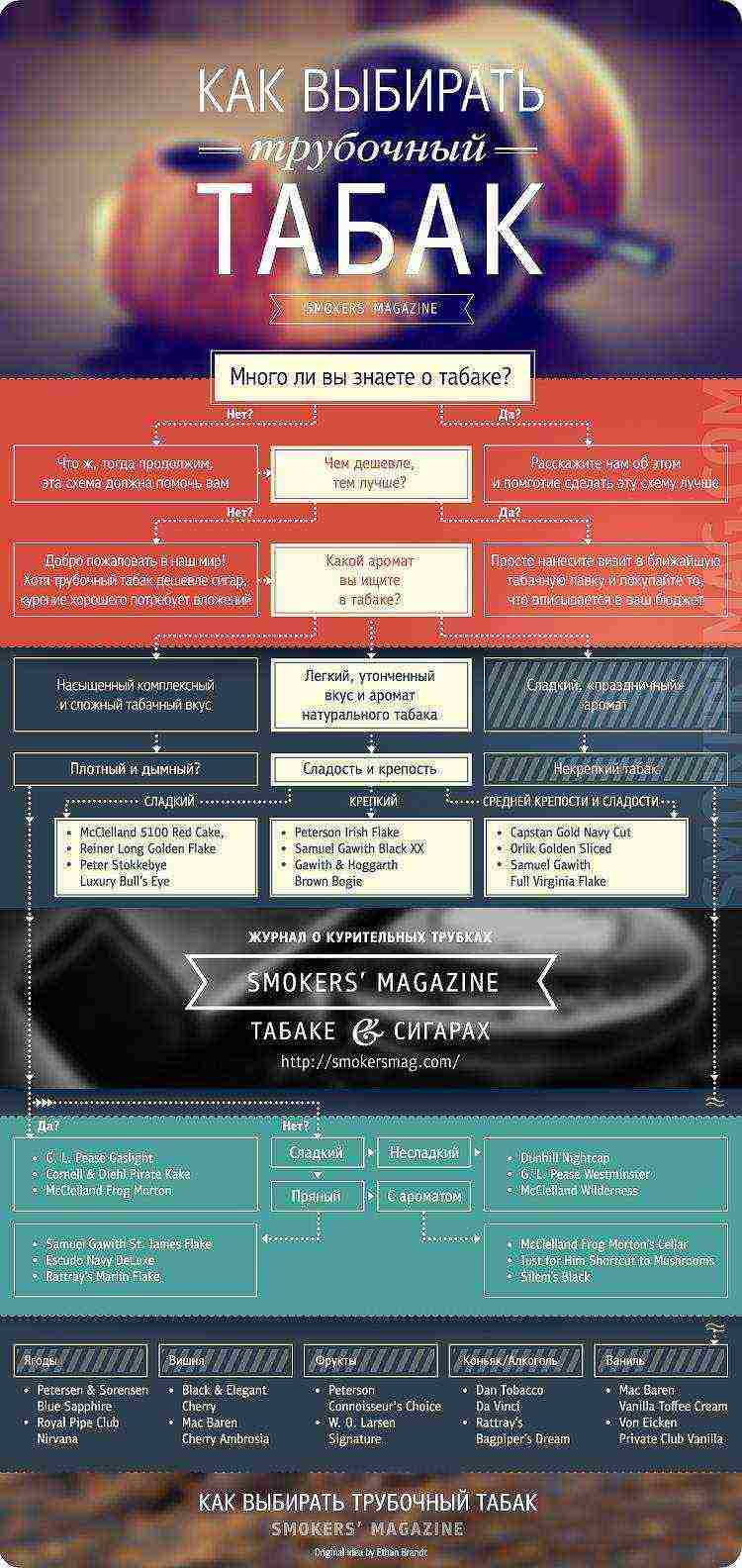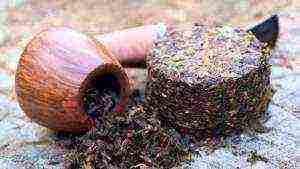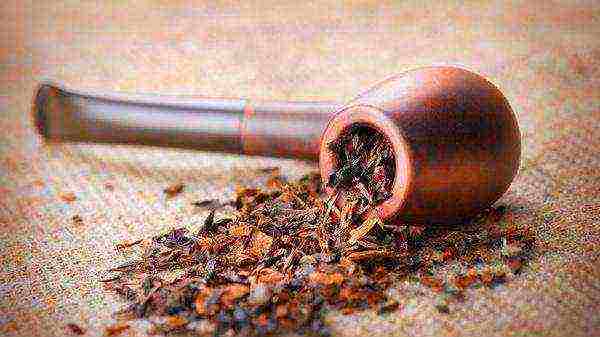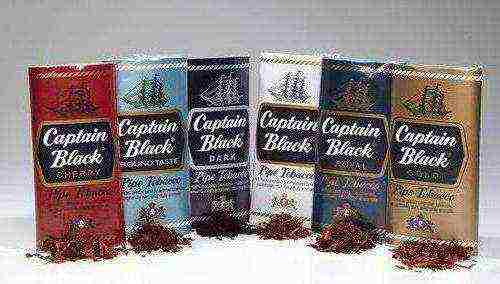Content [show]
One of the most compelling aspects of smoking pipe tobacco is the wide, if not the widest, selection of pipe tobacco varieties, brands and flavors. However, this is also a rather big problem when it comes to choosing one specific tobacco blend from the entire variety presented. Even what we call the “natural taste of tobacco” has an almost limitless range of taste shades, notes, influences that fit well into the framework of “naturalness”, but what about flavored tobacco blends ... And how to navigate in all this?

What do the inscriptions on the tobacco cans tell us?
Let's first try to figure out where such a huge number of flavors can come from? First of all, of course, a lot depends on the place where the tobacco grows, on the soil in which the tobacco bush grew. Different soil composition saturates tobacco leaves with different substances in different proportions. In excellent climatic conditions, the tobacco bush acquires various properties that are characteristic only of tobacco in specific regions - this is how varieties and types of tobacco are formed. And all this, of course, directly affects the taste that the tobacco leaf will give when smoked.
But that's not all. Throughout the long history of tobacco cultivation and smoking, people, having once discerned the potential of a tobacco leaf, tried to improve its taste, suppressing its negative sides and trying to "exalt" the best that liked the taste of tobacco. This is how methods of fermentation of tobacco appeared in various conditions, all kinds of methods of processing tobacco, its storage and aging. And each of the stages that a tobacco leaf goes through from planting a bush to the final stage of processing brings its own changes in taste.
What is pipe tobacco made of?
How to choose pipe tobacco?
Which tobacco should you choose for your pipe?
Basic components of tobacco blends
Pipe tobacco is not just tobacco per se. It is a mixture of different types of tobacco, components that have gone through different stages of processing. By mixing these components in different proportions, blenders achieve different "sound" of the final tobacco blend. There are components that give the tobacco a rich flavor, others give the mixture strength and aroma, there are components that "work" as seasonings, and which can both improve the overall taste of pipe tobacco, and hopelessly spoil it. So what are these components? Let's take a quick look at them.
Burley | Burleigh
Burleigh is not just an ingredient, it is a variety, and one of the most common tobacco varieties used in pipe tobacco blends.Its popularity is due not only to its natural characteristics, but also to the peculiar versatility of this tobacco, expressed not only in the return of its taste, but also in the absorption of third-party flavors. Burleigh itself is a low-sugar tobacco, often high in strength, and burning slowly and coolly.
Read more about Burleigh tobacco in one of our articles.
Cavendish | Cavendish
Cavendish is usually obtained from Burleigh or Virginia by pressing the tobacco leaves, most often subjecting the tobacco to heat treatment during pressing. This helps to "bring to the surface" the natural sugar of the tobacco leaf, which, of course, affects the taste of the tobacco. It is not uncommon for Cavendish to be additionally sweetened and flavored during preparation.
Read more about Cavendish tobacco in one of our articles.
Kentucky | Kentucky
Kentucky tobacco is a "derivative" of the Burleigh variety, the leaves of which are fire-dried, so that the tobacco retains its strength and acquires a dense, rich aroma. In addition, Kentucky can be subjected to other methods of processing, but "languishing" hanging tobacco leaves in barns, in the smoke of smoldering logs is its distinctive feature.
Latakia | Latakia
Like Kentucky, Latakia is tobacco leaves smoked in hot smoke. But as the basis for this component of the mixture, not Burley is taken, but oriental Oriental varieties of tobacco (usually Smyrna), which in themselves already have a characteristic, unique taste. The use of only a certain type of wood for smoking gives the tobacco a recognizable and rather powerful aroma.
Read more about Latakia tobacco in one of our articles.
Oriental | Orientals
Orientals is the name for a whole group of tobacco grown in Turkey, Greece, Bulgaria and other countries. Tobacco from each region has its own flavor differences, but most often the presence of this tobacco in the tobacco blend is simply referred to as "Orientals". Oriental leaves are small in size and usually dry in the open sun.
Perique | Perique
Perique is just one of those "pirates" that we talked about above. Due to the rather complicated and long-term processing that tobacco leaves undergo, Perique acquires a peculiar bright and quite rich taste and aroma.
Read more about Perique tobacco in one of our articles.
Virginia | Virginia
Virginia is one of the most sought-after tobacco varieties in the world. Its leaves contain a fairly large amount of natural sugar, and Virginia's "disposition" to various types of fermentation and tobacco processing methods allows to achieve a large number of flavors of the final tobacco.
This is not a complete list of components that can be included in tobacco blends for smoking pipes. But these are the main and most common ones.
Read more about Virginia tobacco in one of our articles.
How Do I Pick the Good and Right Pipe Tobacco?
Knowing what pipe tobacco actually consists of doesn't tell us much yet, right? Of course, in order to get an idea of tobacco, you need to know and understand how the components behave in the overall mixture. And this means that you have to try and get your own experience. But you still have to start somewhere.
Tobacco by taste can be grouped into large groups and there is already an established classification of flavor groups of tobacco blends, but now we will use a generalized scheme that can help you at the initial stage of tobacco selection.
Aromatics | Flavored Tobacco Blends
Whoever says anything and no matter how much he wants the opposite of a true "pipe aficionado", since its inception, flavored tobacco blends have remained the most sought-after and best-selling pipe tobacco blends in the world.Usually such mixtures are based on Burleigh, Cavendish and Virginia, but the presence of all three components at once in the mixture is not a prerequisite. Although the presence of sweetened Burley Cavendish can be called a distinctive feature of such tobacco. Sometimes other ingredients may be included in the mixture, including Latakia.
The very name of this group suggests that it combines flavored, flavored tobacco - tobacco with added flavor. Here you can find tobacco flavored with mango or grapefruit, chocolate or cognac, coffee, Christmas cake or blueberry pudding. In a word, everything that only the soul desires, except perhaps, in fact, tobacco.
Despite its popularity and the fact that it is the "exotic" flavors spread by tobacco during smoking that attract new smokers, the choice of flavored tobacco as their first tobacco blend must be approached with caution. Very often, flavored tobacco is quite moist, which can lead to hot smoking and burns to the tongue while smoking. In addition, you will not find a taste similar to the aroma of tobacco in such mixtures, alas. But pleasant aromas can inflame the desire to take more from tobacco, which will be expressed in deeper and stronger puffs.
I understand that tobacco with a pleasant aroma is exactly what you can desire here and now, and I am not saying that you should give up the choice of flavored tobacco blends, I am just talking about some restraint and caution both in the choice itself and while smoking.
Burley mixtures
As the name suggests, Burley is the main ingredient in these tobacco blends. And not rarely - the only one. These tobacco blends were popular in the United States and from there their popularity spread throughout the world, and many of the pipe tobacco manufacturers have Burley blends in their assortment. These are not necessarily highly flavored or simply flavored tobacco blends, Burleigh can delight smokers with its mild taste and cool, unhurried burning with a pleasant aroma, including for others. These blends may well be a starting point for beginners, but it's worth remembering that Burleigh used in inexpensive pipe tobacco can have distinctive flavors that may not appeal to all smokers. You should not be afraid of this, but you should not forget about it either.
Virginia blends
Virginia is present in almost all blends, but nevertheless, pure Virginia blends should be bypassed at the initial stage of acquaintance with smoking pipes and pipe tobacco, no matter how tempting and fascinating you might find reviews about such tobacco. The high sugar content of these mixtures results in a higher smoking temperature. Literally, the sophisticated taste of Virginia encourages more and more smoke from the pipe. All this is not very cool. In addition, the very nature of the taste of pure Virginia blends for a beginner may seem unintelligible, which will ruin the first impressions not only of tobacco, but also of pipe smoking itself. Leave Virginia for the moment when you feel enough of the experience of smoking a pipe, and then she will surely thank you with amazing taste and conquer, as has happened to many of us.
Latakia mixtures
Despite its characteristic taste and aroma, in which some recognize creosote, others - Vishnevsky's ointment, mixtures based on Latakia give a soft and cool smoke. There are a huge number of Latakia fans in the world and you should not be afraid of the "scary" descriptions that you could meet on the Internet. Very often, Latakia is sympathetic to the mistakes of newbies when smoking, so do not ignore such mixtures when choosing your first tobacco blends. It may even be a better choice than thick and fatty flavored blends.
Tips for choosing pipe tobacco
The diagram below is not original, and the idea of its creation belongs to Ethan Brandt (Briar Portrait Gallery), the merit of Smokers' Magazine here is only in translation, creation of illustrations and in "easy adaptation" to today's realities. Which is also not a little, right? Anyway, we hope this diagram will help you make your first choice.

The diagram is not a complete and complete guide to pipe tobacco selection. It only indicates the direction in which you can take your first steps towards choosing a tobacco blend. Then you just have to try, try and try. Draw conclusions and try further. I would like to note that you should not be intimidated if something did not suit your taste now or if something went wrong as you wanted. You should not ignore pipe tobacco or even its entire flavor groups based solely on other people's statements - there is a high probability that you will miss the truly outstanding masterpieces of tobacco art. Try it yourself, try everything and make your own opinion, get your own experience. And then the doors to a truly amazing and vibrant world of smoking pipes and pipe tobacco will open before you.
Cool smoke!
Where to buy tobacco and cigars?
Consulting and advice on the choice of pipes, pipe tobacco and cigars.
Conservative smokers place great emphasis on the characteristic flavor when choosing tobacco varieties for their pipe. Stimulants and impurities do not always denote the good quality of the tobacco and the enjoyment of smoking. The main flavor when smoked comes from the tobacco leaf used, which is determined by the variety. When buying pipe mix, look at the product packaging. The type of tobacco can tell you a lot about a product.
The main varieties of pipe tobacco
The most famous tobacco in the world - Virginia
The Virginia variety is produced in an amount of up to 70 percent of the total volume of tobacco produced. The name of tobacco is associated with the former colony of Britain. This variety has a pleasant taste due to its high sugar content. This type of tobacco contains 1 -3.5% nicotine. Virginia is a very soft tobacco with a subtle and delicate flavor that attracts the attention of smokers.
Leaves, after harvest, are dried for up to 5 days, then processed, fermented for about 2 years, then sorted by quality and color. Thus, the raw material for the further manufacture of pipe tobacco is obtained.
Unrivaled Nut Tobacco
The tobacco variety has a brownish-matte shade and a very tart nutty smell. It is a light smoking material due to its nicotine content of only 1.5 - 4%. If we compare with Virginia, then there is little sugar, in this regard, when preparing the product, it is thoroughly soaked in syrups and sweeteners.
They dry it in open barns, where air circulation is free. The drying process takes 1-2 months.
Group of specific types of tobacco Spice Tobacco
This broad group includes:
1. Oriental Tobacco, which is produced in Bulgaria, Yugoslavia, Greece, Albania, Romania and some other countries. The variety is distinguished by small oval leaves with a yellowish tinge. The sweetish aroma of tobacco allows its use by the manufacturers of exotic cigarettes in Egypt.
2. Latakia tobacco obtained as a result of fire drying using aromatic tree species. Grown in northern Syria and Cyprus. Latakia is a tobacco with a rather rich taste and is widely used in English blends.
3. Tobacco Perique very specific, produced in small quantities. Grown in southern Louisiana. After harvesting, the leaves are placed in oak barrels with spices, fruit pulp and plum juice. This is the fermentation of the leaves throughout the year. The result is a very dark tobacco with a high nicotine content.
4. Kentuky Tobacco named after one of the states of America.Today it is grown in Tanzania, Malaysia, Poland, Indonesia and Italy. The variety has a smoked flavor. The tobacco itself is used in small quantities due to the high content of nicotine in its composition.
Cavendish as a tobacco processing method
Cavendish is a type of tobacco that is often equated with a special processing method. It can be produced from virtually any type of tobacco. Mostly Virginia and Burley are used.
To get the Cavendish, manufacturers press several varieties into special tiles, which then go through a fermentation stage. When the tobacco takes on a sweet, savory flavor, the tiles are cut into flakes. The modern variation of Cavendish can be anything: cherry, chocolate, vanilla, strawberry, etc.
Most wanted - flavored tobacco blends
The most sold and demanded in the whole world are tobacco blends. They are made on the basis of Virginia, Burleigh, Cavendish and other varieties of tobacco. This blend of several varieties of tobacco is diluted with flavors that bring a whole new flavor to the pipe. It can taste like grapefruit or mango, cognac or chocolate, pudding or even Christmas cake. Here, manufacturers are experimenting as best they can.
The main varieties of tobacco blends
- Berliyevs, are prepared on the basis of Burley tobacco. These are very popular blends in the United States that have found their fans on other continents as well. Almost all manufacturers of tobacco blends have such products in their assortment. Burley blends delight smokers with their somewhat cool, mild taste; a pleasant aroma envelops and allows you to relax. It is these mixtures that can be a starting point for novice smokers;
- Virginia - it is worth avoiding a little at the initial stage of acquaintance with smoking tobaccos. Smoking of such mixtures, especially in pure form, occurs at high temperatures. It is characterized by a high sugar content, while the very sophisticated taste of smoking induces to draw in large puffs of smoke. This phenomenon does not have a very healthy effect on the body, and the taste of a novice smoker can be confusing and make an unintelligible impression. Virginia blends are worth trying when you already know what to expect from them;
- Latakia characterized by a specific aroma and taste. Many people recognize in this mixture creosote, Vishnevsky ointment, etc. With all this, there are a myriad of fans of this mixture in the world.
Choosing pipe tobacco
To make the right choice of tobacco, you should rely on certain parameters. First of all, this is the level of the fortress. Each variety is characterized by the amount of nicotine content to consider. For the first smoking, you should not purchase strong tobacco.
Soaking tobacco in sauces
Tobacco is made using sauces. This is the liquid in which the product is soaked to obtain a specific flavor. This sauce can be completely neutral, it does not affect the outgoing taste of the smoke. Expensive varieties are soaked in natural ingredients such as honey, fruit syrup, etc. Cheaper tobacco is made using chemistry.
So, when buying tobacco, rely on your taste preferences.
Methods for cutting pipe tobacco. The choice of tobacco is also influenced by the way it is cut.
The product is presented in stores in three variations:
- sliced;
- in flakes;
- in briquettes.
The first option can be used with a cut from the container. The second is pressed tobacco leaves, pre-cut into slices. These pieces are fluffed up and clogged like regular tobacco. The last type - briquettes need to be cut yourself. This is best done by a professional and true pipe smoking connoisseur.
How to choose tobacco
It is recommended to try three types of tobacco for a start: Old Dublin (Latakia), Sherlock Holmes (Virginia) and NuttyCut (aromatic).These are not strong varieties and are offered to customers in a pre-cut, ready-to-smoke form.
If you like Virginia the most, then you can safely purchase Samuel Gawith Full Virgina Flake. This tobacco is slightly stronger than the first option. You can also try Golden Glow or Black XX Twist from Gavis. Virginia Peterson University Flake tobacco is also moderately strong.
If you prefer Latakia, you should try Samuel Gawith Balkan Flake, Navy Flake or Skiff Mixture. The choice among aromatics is very wide. This could be, for example, Mac Baren or W.O. Larsen.
 Experienced pipe smokers know how difficult it is to find quality pipe tobacco to their taste. It is much more difficult for beginners in this business. It is necessary to figure out by what criteria you can make your choice.
Experienced pipe smokers know how difficult it is to find quality pipe tobacco to their taste. It is much more difficult for beginners in this business. It is necessary to figure out by what criteria you can make your choice.
When buying pipe tobacco, experienced smokers pay attention to the packaging. After all, varieties of pipe tobacco can tell a lot about their characteristics. The presence of impurities and flavors in the composition is not always a sign of good quality. The key to the good taste of a cigarette is the tobacco leaf that is used in its manufacture.
- Virginia is the most widely used tobacco worldwide. It has a pleasant, mild taste that is popular with many smokers. It contains a large amount of sugar. Nicotine accounts for 1-3.5% of the volume of all elements. The drying process takes up to 5 days. Fermentation takes about 2 years. After that, the raw materials are sorted according to color shades and quality.
- Nutty - has a tart nutty aroma and a brown-matte shade. Nicotine contains 1.5-4%. There is less sugar than Virginia. Leaves are dried up to 2 months in an open barn with good air circulation.
- Oriental pipe tobacco has small yellowish oval leaves. Used in the manufacture of Egyptian tobacco products.
- Latakia is produced by fire drying with aromatic trees. It is often found in mixtures of English origin.
- Perique, after harvest, is placed in oak barrels with the addition of spices, plum juice and fruit pulp. Fermentation takes about 1 year. The result is a dark filler and a high nicotine content.
- Kentucky has a smoky flavor. There is a lot of nicotine in the composition, therefore, it is used in small quantities.
- Cavendish tobaccos are processed according to a special method. It is produced from almost all types of tobacco. Burleigh and Virginia are most often used for its manufacture. Several types of tobacco are pressed into tiles by the manufacturer. In this state, fermentation already takes place. The product should acquire a sweetish and piquant aroma. Then it is cut into flakes.
Slicing types:
Several types of tobacco cutting are noted so that the smoker does not make the extra effort before use as was the case in the past. Types of standard cuts:
Shag - a thin cut across the sheet. It is used more often for juicy Cavendish, which does not go out due to such grinding. The smoke is dry and hot.
 Ribbon - the leaves are cut finely along the leaf. Thin and long pieces are formed. Applied to Virginia. Provides good smooth combustion and coolness of smoke.
Ribbon - the leaves are cut finely along the leaf. Thin and long pieces are formed. Applied to Virginia. Provides good smooth combustion and coolness of smoke.
Ready rubbed - assumes raw materials of coarse grinding, processed under the press.
Wild Cut - each tobacco included in the composition is cut in a suitable variety of ways. This will ensure a uniform combustion even with a wide variety of raw materials.
Plug - molasses and flavorings are added to raw materials during production. The leaves stick together and are processed under a powerful press.
Flake - raw materials are crushed into thin and neat pieces, pressed.
Round cut - Represents a rare and expensive cut. The leaves are rolled together and wrapped in a common cover. The aging of the sausages and the fermentation procedure takes place in a complete state. After that, cutting into circles with a cylindrical shape is performed.
Cube - pressed tobacco is cut into cubes. Smokes hard, but it can be stored for a long time.
You can buy different varieties of tobacco in stores:
- chopped - apply immediately from the container;
- in a briquette - cut yourself;
- in a flake - pressed products, fluffed and hammered into a tube before use.
Pipe types of tobacco are divided into groups depending on tastes and flavors:
- English mix. Produced on the basis of Latakia, Oriental and Virginia. Perique is sometimes added. Means quality and consistency for experienced smokers.
- The American type of tobacco blend is made on the basis of Burleigh and Cavendish. They have a sweetish taste, are relatively light in the process of smoking. Seasoned with flavors and heavily sauced.
- Tubular Dutch mix type. Seasoned with oriental orientals and spices.
- The Danish blend is flavored with spices and bright alcoholic undertones. Used for the manufacture of Cavendish and Virginia, sometimes Perique and Kentucky.
- The French blend involves the addition of a cigar leaf to the composition. This type is quite strong when smoked and carries the aroma of Havana cigars.
Among connoisseurs of pipe tobacco, Klan tobacco is considered one of the most popular types. Its recipe is known only to a smaller number of production representatives and is kept in the strictest confidence. Clan Aromatic pipe tobacco. is a mixture of 14 different varieties and types of raw materials. It has a mild taste of chocolate, whiskey and caramel.
The history of pipe smoking goes back several centuries. Therefore, it is not surprising that for this special types of tobacco were bred and special types of cutting were developed. After reading this article, you will learn how to choose pipe tobacco.
Main varieties
The "Virginia" variety is often used as a base for pipe tobaccos. Today, several varieties of this plant are known. They all have a delicate aroma and light leaves.
Other varieties are added in small amounts to increase the strength and create a special bouquet. So, when adding the "Kentucky" variety, the mixture has a dark brown hue and plum aroma.
Oriental pipe tobacco is grown in Eastern Europe, with a mild aroma and a slightly sweet flavor. Turkish varieties have a more pungent aroma.
Classification of tobacco blends
Depending on their taste, they can be roughly divided into:
- pure unflavored "virginia";
- mixtures with the addition of "latakia";
- aromatics.
In addition, there is a classification into English and Danish flavor groups. The first includes "latakia" and "virginia", the second - aromatics. There is also another, French group, which includes blends of pipe and cigarette tobacco.
Cutting and strength of tobacco
In nature, there are both too light and overly strong varieties. Unlike classic cigarettes, in this case, the strength is measured not by the concentration of nicotine, but by the taste. For those choosing their first pipe tobacco, the lighter varieties are recommended.
There are three forms of tobacco you can buy in stores:
- Sliced. It is sold in special jars and is completely ready to use.
- In flakes, which are sheets of tobacco pressed into piles and cut across. These plastics can be used in two different ways. Some roll them up and put them in a chamber, while others fluff up the plates and hammer them in like ordinary cut pipe tobacco.
- In briquettes requiring self-cutting. Such tobacco is strong enough, therefore, it is better for novice smokers to refuse to purchase it.
Captain Black pipe tobacco
This natural classic with light vanilla notes is especially popular with American citizens. It is ideal for connoisseurs of light tobacco blends. When smoked, a pure natural vanilla aroma is felt.Unfortunately, captain black pipe tobacco, reviews of which sound exclusively in a positive way, is not very common among our compatriots. But those who have already appreciated it, assure that it is much more pleasant than many other mixtures. True, there are those who absolutely do not like this tobacco. They motivate this with a rather coarse cut and not the best quality of tobacco. Plus, you'll have to tinker with pipe cleaning after smoking this wet variety.
Is it possible to grow pipe tobacco at home
It should be understood that this plant requires a long frost-free period, the duration of which should be at least 120 days. That is why it is better to use the seedling method for growing tobacco.
This plant has very small seeds. One gram of tobacco contains more than 10,000 pieces. Therefore, when sowing, it is advisable to use ballast, for which humus sifted through a sieve is ideal. A good result is obtained when using a nutrient mixture consisting of one part of sand, one part of forest land and two parts of humus. The soil for the mixture should be exactly forest, since pathogens of the viral mosaic may appear in the garden soil.
The air temperature in the room in which the seeds germinate should be at least 18 and not more than 22 degrees. The emerging seedlings should be provided with maximum illumination, otherwise the seedlings will develop poorly.
After a month and a half, she is completely ready for planting in the ground. By this time, the height of seedlings with five full-fledged leaves should be approximately 12-14 cm. A week before the date of the proposed planting, it is recommended to start hardening the seedlings so that it gradually adapts to the relatively low moisture content of the soil. A couple of days before planting, you need to completely stop watering.
During planting, it is important to ensure that the growth point is not covered with earth. To stimulate the appearance of additional roots that form from the cambial cells of the stem, the seedlings can be deepened into the ground to the level of the lower leaves.
We must not forget about the density of standing tobacco. So, on one square meter of land, you can plant no more than five plants of large-leaved varieties and no more than twelve small-leaved specimens. Seedlings should be planted only after the threat of recurrent frosts has passed.






